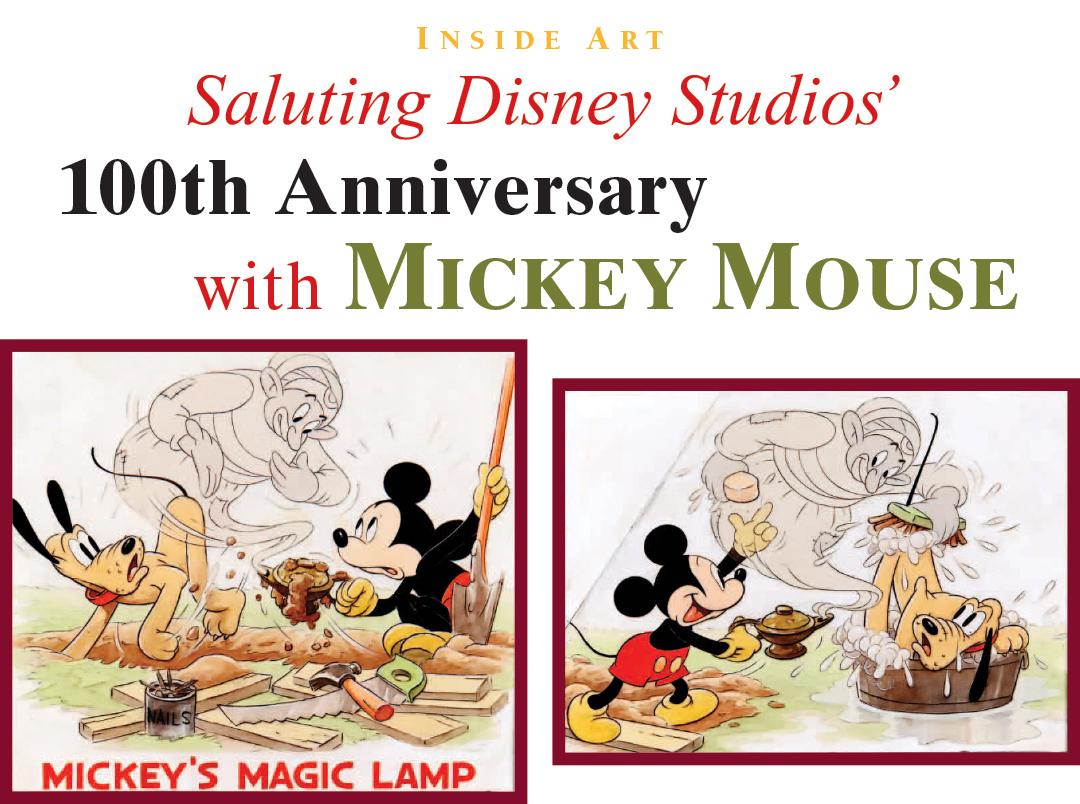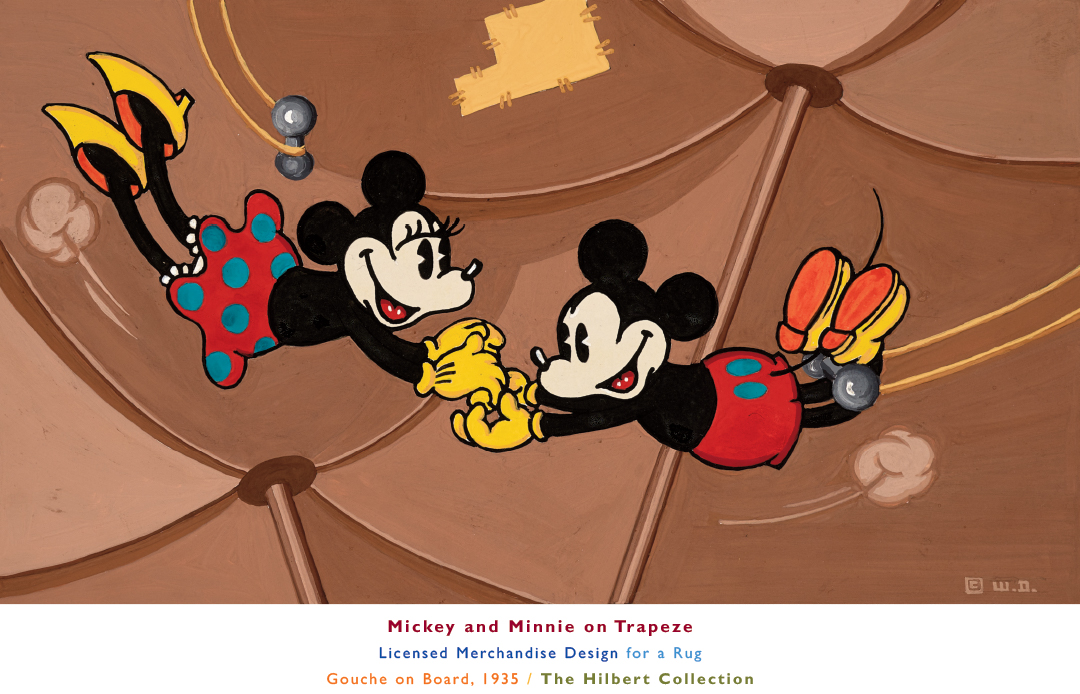
WALT DISNEY PRODUCTIONS
Tom Wood (1870 - 1940)
Mickey’s Magic Lamp
Illustrations for Good Housekeeping magazine
1940 / Gouache on board
The Hilbert Collection
- - - -
What better character to celebrate Disney Studios’ 100th birthday (1923-2023) than the superstar himself: Mickey Mouse? Mickey isn’t quite as old as Disney Studios—he was “born” in 1928. But he remains arguably Disney’s most popular character worldwide.
The Hilbert Museum, currently in its temporary location at 216 East Chapman Ave. while its permanent expansion on Atchison Street is under construction, salutes The Mouse with a focused exhibition of original Disney drawings, concept paintings and cels, on view now through the end of the fall.
Mickey’s very creation was well-nigh miraculous. A dejected Walt Disney was riding the train home to California from New York in 1928, having just lost the rights to his most popular cartoon character, Oswald the Rabbit, to his distributor. In one fell swoop, Walt had lost his main source of income, and would need to start all over again.
But rather than sink into fury and despair, as many would have, the resilient Walt sat on that train and thought and thought, and then started sketching.
Soon, a cute little mouse character emerged from his pencil. Mickey Mouse, says Disney biographer Neal Gabler, was the product of “desperation and calculation,” but would go on to become an international phenomenon and the iconic symbol of one of the most successful entertainment empires in the world.
Mickey made his debut in Steamboat Willie in 1928. The short film was the first to feature synchronized sound and was an instant hit. Audiences fell in love with Mickey’s infectious energy and charm, and the character quickly became a sensation.
Mickey’s success had a profound impact on Disney Studios. The studio had previously struggled to find consistent success with its animated shorts. But with the success of Steamboat Willie, they found a winning formula. They began producing more Mickey Mouse shorts, as well as other animated shorts, developing new characters like Donald Duck and Goofy.
The success of Mickey Mouse also helped propel Disney Studios into the world of feature films. In 1937, the studio released its first feature-length animated film, Snow White and the Seven Dwarfs. The film was a massive success and is still considered one of the greatest animated films of all time.

So, The Mouse launched an entertainment empire. But also instrumental in launching that empire was Walt himself, whose entrepreneurial skills and innovative marketing ideas added to the studio’s successes.
One example of this in the current exhibition is the painting shown on the inside front cover of this issue. “Mickey and Minnie on Trapeze” is a licensed design for a Disney-themed series of character rugs that were created in the 1930s to decorate children’s bedrooms and playrooms. Walt Disney was among the first to conceptualize and license his movie characters as merchandizing opportunities.
Mickey Mouse’s image first appeared on a children’s pencil tablet in 1923, the same year he was created. The manufacturer paid Walt $300 in cash for the rights to use Mickey on the tablet. Thousands of families bought the tablet, and one of the most successful merchandizing businesses in history was born.
By the mid-1930s, Mickey’s image was on toys and other products everywhere, along with Donald Duck, Goofy and other popular characters in the Disney stable. The most popular, of course, were Mickey Mouse watches and clocks. All of these were designed by Disney’s own artists, to maintain the brand’s look and consistency.
Walt’s salesmanship with commercial and media tie-ins continued. During the decade from 1934 through 1944, every issue of Good Housekeeping magazine—one of the most popular magazines in America, then and now—featured a children’s page devoted to the characters of Walt Disney. This was the result of a mutual promotional agreement between the magazine and Disney Studios, with the idea that parents would share these stories with their children. GH felt that a Disney page in each issue would be a sales plus for the magazine, while Disney liked the idea of a permanent advance publicity break for its latest animated releases.
The partnership ran from April of 1934 through September 1944. The pages were drawn and designed by Disney artists: From 1934 to 1941, they were drawn by Tom Wood, then from 1941 to 1944 by Hank Porter. In 2005, David Gerstein compiled all the Good Housekeeping Disney pages into a book: Walt Disney’s Mickey and the Gang: Classic Stories in Verse.
These are among the fascinating selection of original Mickey art on display now at the Hilbert Temporary. And of course, Mickey Mouse’s impact continues to make itself felt far beyond the world of entertainment. He has become a symbol of childhood and innocence, and a testament to the joy and power of storytelling. His image is instantly recognizable to people of all ages. Throughout all the world’s changes and turmoil, Mickey Mouse has remained a constant, reassuring presence—reminding us that no matter what happens, there’s always a reason to smile.
Disney at 100: MICKEY MOUSE
Now through November at the Hilbert Temporary,
216 East Chapman Ave., (1 ½ blocks east of the Plaza).
Open Tues-Sat, 11am to 5pm, free admission.
More information: 714-516-5880 or www.HilbertMuseum.com



